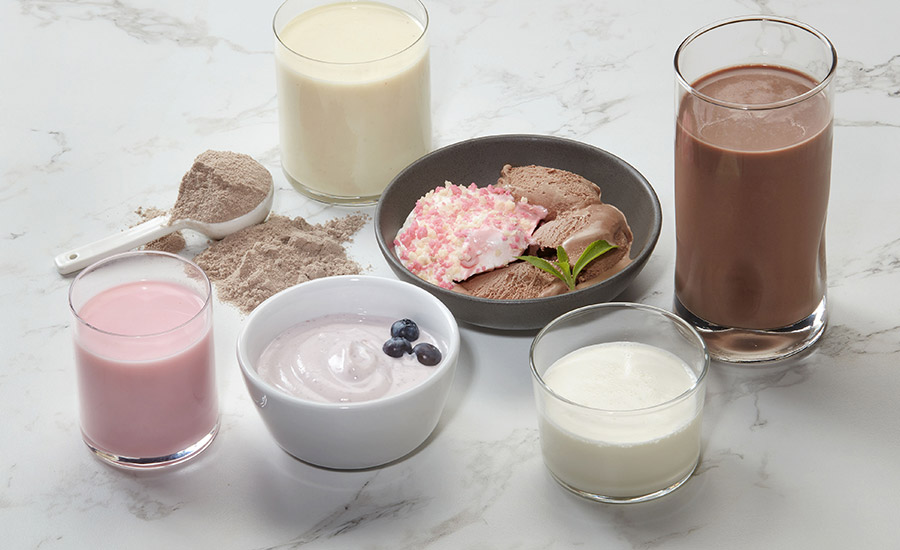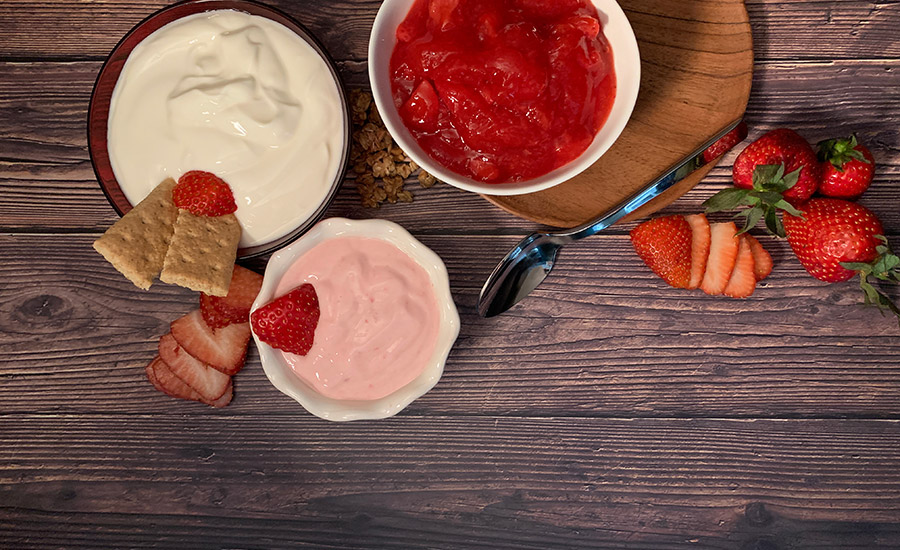Most dairy and plant-based products require gums, emulsifiers and stabilizers to enhance thickening, creaminess
Pairing the right hydrocolloid in the right application pivotal for success.

Most dairy and non-dairy products require an ingredient to stabilize the finished formulation. The exception? Fluid milk, without any flavorings or added functionality, doesn’t require any stabilizers, texturizers, or gums.
Photo courtesy of BENEO.
When making gravy or soups, processing ice cream, yogurt, or sour cream, creating the filling for a frozen dairy desser,t or adding texture to an analog/vegan cheese, hydrocolloids are essential thickening and gelling ingredients to help dairy processors attain the desired viscosity, mouthfeel and creaminess of a wide range of products.
Hydrocolloids such as gums, emulsifiers and stabilizers — powerful workhorse ingredients — are go-to ingredients within dairy and non-dairy products as they enhance product quality, extend shelf life and improve a product’s mouthfeel and texture.
Among the thickening ingredients commonly used are starch, xanthan, guar gum, locust bean gum, gum Arabic and cellulose derivatives. Gelling hydrocolloids include alginate, pectin, carrageenan, gelatin, gellan and agar.
Parsippany, N.J.-based BENEO offers a range of natural ingredients including inulin and oligofructose from the chicory root, rice flour, starch and protein, functional carbohydrates from the sugar beet, and faba bean protein and starch.

“Regarding stabilizing ingredients, our rice starch works particularly well as a stabilizer in dairy and non-dairy products by binding water and preventing syneresis in products like yogurt and sour cream. The small granule size of rice starch improves the texture of many dairy and non-dairy products by creating a smooth and creamy mouthfeel,” says Kevin Reed, BENEO’s customer technical support manager.
On the emulsifier side, faba bean protein can be used to enhance product stability in plant-based creamers for example. This also extends to foam stability, for barista-style creamers, Reed adds.
“Gums, emulsifiers and other stabilizers can contribute to the texture and stability of dairy products. These ingredients extend shelf life by water holding or stabilizing an emulsion to prevent separation over time. The extent of these benefits depends on the specific formulation,” says Jordan Stecz (Garry), principal technologist, US/CAN Technical Services at Westchester, Ill.-based Ingredion Inc. “Gums, in particular, can modify food texture by thickening, forming gels or foams, and enhancing the eating experience through varying levels of mouthcoating.”
IFPC Food Scientist ll Emily O’Chiu affirms that controlling water in foods being processed is paramount to why hydrocolloids exist. In short, the St. Louis-based company notes that gums, emulsifiers and stabilizers are essential to producing the highest quality flavored milks and non-fat dairy options.
“Their main role is controlling water (a major component in most foods),” O’Chiu notes. “This could look like building viscosity, forming a gel, preventing separation, or maintaining moisture. A well-developed product containing stabilizers will be incredibly consistent in terms of texture and mouthfeel from the day it is manufactured through the end of its shelf-life.”
Noted for their versatility and ability to expertly work in dairy and non-dairy products, hydrocolloids are crucial for dairy products like ice cream, yogurt and flavored milks. On the plant-based side of the equation with applications like plant-based milks, vegan cheeses and non-fat dairy options, gums, emulsifiers and stabilizers are essential to hit the target texture expectations of the food they are replicating, she adds.
While hydrocolloids are used across a variety of dairy products, including stirred yogurts, spreadable cheese products, puddings and protein beverages, the specific attributes desired in each product dictate the choice of gums, Ingredion’s Stecz states.

Ensuring proper hydration is of primary importance when formulating with gums. As a result, the company recommends dry blending gums with other dry ingredients to achieve even hydration and prevent the formation of “fish eyes” during processing. It’s also crucial to keep the hydration vessel in constant motion to prevent materials from settling at the bottom. Lastly, dairy processors should use the correct amount of gums as too much guar gum, for example, can upset the gastrointestinal system.
Hydrocolloids add thickness, creaminess
Several ingredient suppliers offer a wide portfolio of hydrocolloids, texturizers and stabilizers.
Schoolcraft, Mich.-based J. Rettenmaier USA LP (JRS USA), along with its partner, Silva Team, offers alginates, pectin, MCG colloidal-microcrystalline cellulose (c-MCC), and citrus fiber. The family-owned JRS Group, headquartered in Rosenberg, Germany, has more than 90 production and sales facilities with dairy ingredients produced domestically as well as imported from facilities in France, Italy, Mexico and Germany.
“These ingredients can provide some much needed thickening and creaminess to a product in a variety of conditions. Alginates work well in dairy applications and can provide viscosity, freeze thaw stability, and improved mouthfeel. Alginates have the ability to hydrate and gel without heating. Gel setting time can be controlled by adjusting the calcium concentration when using sequesterants [food additives],” explains Robbert Teerink, national sales manager of food ingredients at JRS USA.
When it comes to stabilizing and thickening yogurt, pectin, at a dosing rate of 0.1-0.5%, helps prevent product phase separation and controls syneresis. It also provides a creamy to gelled texture in milk-based desserts, while providing enhanced mouthfeel with protein protection in acidified protein beverages, he adds.
Teerink notes that alginates and low methoxyl pectin both require a calcium source to form a gel, which can be added with the addition of sequestrants. He points out that the gelling ingredient pectin — a white-to-light-brown powder produced from edible citrus fruits — is classified into three subsets: high methoxyl (HM), low methoxyl conventional (LMC) and low methoxyl amidated (LMA).
When formulating with these ingredients, Teerink notes how clean-label pectin and citrus fiber and some celluloses work.
He explains: “High methoxyl pectin requires high solids and a low pH to form a gel while low methoxyl forms a gel with the addition of calcium ions. MCG, when activated, can be used in pH neutral beverages, ice cream, sauces and dressings to stabilize and suspend particles while imparting body and a creamy mouthfeel. MCG dispersion networks are activated with high shear, thermally stable and thixotropic in nature, and retain the desired viscosity post processing. Finally, citrus fiber can also provide viscosity, rich mouthfeel, enhance overrun, and improves freeze/thaw stability, while keeping a neutral flavor profile and remain friendly on an ingredient label.”

River Falls, Wis.-based Fiberstar Inc. manufactures Citri-Fi citrus fiber, which is produced from byproduct of the citrus juicing industry in a chemical-free extraction process.
Noting that its upcycled Citri-Fi was developed more than 20 years ago, the heat stable, low pH and freeze/thaw stable ingredient provides high water holding and emulsification properties due to the high surface area of the fibrous composition, says Jennifer Stephens, Fiberstar’s vice president of marketing.
“In shear conditions, Citri-Fi provides additional viscosity which is needed in some dairy products,” she says. “At low usage levels (<1%), Citri-Fi benefits a variety of dairy products. For instance, in dairy-based and dairy alternative yogurts, sauces and dips, Citri-Fi minimizes syneresis and creates a natural smooth mouthfeel.”
Meeting clean-label trends
Experts note that the clean-label trend along with sustainability claims are important particularly as consumers are increasingly aware of the ingredients found in their favorite foods.
In fact, Fiberstar’s Technical Sales Manager Sheila McWilliams suggests that fluid milk, without any flavorings or added functionality, is the only dairy product on the market that doesn’t include an ingredient to stabilize the finished formulation.
“Most other products like dairy beverages, dips, spreads, yogurt, and frozen products likely contain some type of ingredient for stabilization,” McWilliams explains. “A product may need an emulsifier to stabilize the water and fat phases, a gum to manage water, or another stabilizer to provide viscosity and improve texture.
“One of the challenges for dairy processors is formulating quality and functionality along with balancing consumer needs for a clean label product,” she continues. “Citri-Fi citrus fiber is functional, upcycled, natural fiber and can be labeled as dried citrus pulp or citrus flour.”
The fact that some hydrocolloids come from plants is an added benefit. IFPC’s O’Chiu notes, “Many high performing hydrocolloids like guar gum and acacia gum are derived from plants and are very well received by consumers. They can do the work of replacing less label-friendly ingredients like modified food starch, or mono and diglycerides.”
A leading hydrocolloid distributer with a global network of ingredient suppliers and distribution centers across the U.S., IFPC offers custom blending solutions created by its Ingredient Technology & Application’s team. O’Chiu suggests that gums, emulsifiers and stabilizers typically need to be used in combinations of multiple ingredients, each with very specific use rate requirements.
For dairy products such as ice cream, yogurt and cheese, alginate, at a dosing rate of less than 1%, creates thickness and gelling, JRS’ Teerink states. The ingredient also is used to produce alternative cheese, crafting creaminess, texture and flexibility of the protein and fat base, he adds.
“In general, pectin, citrus fiber and alginate are considered clean label,” Teerink notes.
Since rice is a staple food many consumers use in their own kitchens, rice ingredients can be considered appealing ingredients on product labels, according to BENEO’s Reed, pointing out that the company offers a variety of natural, native rice starches that can be labeled as “rice starch” on the ingredient declaration.
Even with clean-label dairy products, working with hydrocolloids presents many challenges that product developers need to overcome.
“In products like yogurt, improving emulsion stability throughout shelf-life, reducing sugar without sacrificing sweetness and flavor, and using clean label stabilizers and emulsifiers without compromising performance [makes a difference],” Reed explains. “Many of these challenges are the same for non-dairy products but also include selecting ingredients that can have similar emulsification and foaming properties to dairy proteins and balancing protein sources to improve the amino acid profile of the product.”
Experts like IFPC’s O’Chiu and JRS’s Teerink note that choosing a knowledgeable ingredient supplier and communicating the company’s goals for each new product is pivotal for long-term success.
“Partnering with experienced developers can save time to market for a new product launch or improve accuracy and control potential errors in existing products,” O’Chiu states.
JRS’s Teerink affirms that one of the greatest challenges when formulating with dairy products is being able to pair the right hydrocolloid to the right application within the processing parameters.
“This is why it is so important to share information so the supplier can recommend the best solution,” he concludes. “Some products may require sufficient shear to activate or have an optimal point of addition in the process. It’s also necessary to know the functionality the processer is aiming to achieve, such as if they are only interested in improving texture and mouthfeel or if there is a functional need to provide, such as emulsification, protein stabilization, or reducing ice crystal formation in a frozen dessert.”
Looking for a reprint of this article?
From high-res PDFs to custom plaques, order your copy today!




.jpg?height=200&t=1699542015&width=200)

